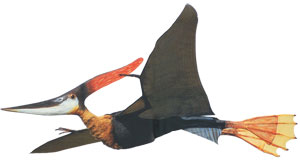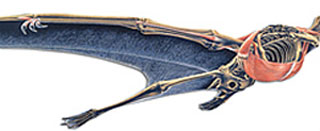Bigotry: The Dark Danger
The Origin of Birds and Flight

DOWNLOAD THE BOOK
CHAPTERS OF THE BOOK
- Foreword
- Introduction
- Evolutionist Scenarios and Dilemmas Regarding the Origin of Flight
- Important Structural Differences Between Dinosaurs and Birds
- Archaeopteryx is an Extinct Species of Bird, Not an Intermediate Form
- The False Fossil Archaeoraptor: An Example of Evolutionist Fanaticism
- Imaginary Dinosaur-Bird Links
- Pterosaurs - A Dilemma for the Theory of Evolution
- The Origin of Flight in Insects
- Conclusion
< <
8 / total: 10
Pterosaurs - A Dilemma for the Theory of EvolutionFlying dinosaurs are referred to as pterosaursby scientists. These reptiles first appeared in the Upper Triassic period, around 200 million years ago, and later became extinct. These creatures possess the basic features of the reptiles: Their metabolisms are cold-blooded unable to produce their own internal heat, and their bodies are covered in scales. However, thanks to their powerful leathery wings, they could fly. Recent research has shown these creatures' superior abilities. The first X-rays to detail their skulls led to a new understanding of pterosaurs' very sensitive visual system, and that they used their skin-covered wings very efficiently. The investigations performed by David Unwin of the Berlin Museum of Natural History and Lawrence Witmer of Ohio University were reported in the 23 October 2003 edition of Sciencemagazine:
With wingspans as broad as 10 meters, pterosaurs were impressive predators. . . CT scans revealed the three semicircular canals of the inner ear, for example, which provide the sense of balance. The radius of the looping canals was quite large... Compared to birds, pterosaurs had a remarkably large flocculus. This part of the brain helps coordinate the head, neck, eyes, keeping the gaze steady while an animal moves. Whys such a big flocculus? Witmer speculates that it was receiving signals from the skin=covered wings, which contained muscle fibers. "It's conceivable that they've recruited the wing as a large sensory organ." he says. "That's a important idea and a really exciting one." Unwin says. He says the potential efficiency of such a "smart wing" could help explain how giant pterosaurs were able to get off the ground. 220 A report in New Scientistunder the heading "X-rays reveal pterosaurs aerial expertise" explained further: Pterosaurs, the extinct flying reptiles, had the largest neural system for processing balance information ever seen in a vertebrate. It probably allowed them to perform complex aerobatic maneuvers while keeping their gaze firmly centered on their prey. The flocculus integrates signals from the balance organs, joints, muscles and skin. It sends on neural signals that produce small, automatic movements in the eye muscles to keep the image on an animal's retina steady. Without it, our visual experience would be like a shaky video camera, says Witmer. 221 The smooth imaging system in question possessed by these flying reptiles resembles that used in camera images taken from modern-day helicopters based on a very delicate gyro-stabilized camera. Millions of years ago, these living things possessed a similarly advanced system to that in modern helicopters. Of course, it runs against all common sense to imagine that these flying reptiles acquired their expertise through blind evolutionary mechanisms. This evidence of creation in their sensory systems is by itself a major dilemma for the theory of evolution.
Paleontological discoveries also demonstrate that these flying reptiles were created, since they emerge suddenly and fully formed, with no transitional forms between them and earlier terrestrial creatures. An article published in Science magazine in 1999 admits this situation, which poses a severe difficulty for the theory of evolution: For use in understanding the evolution of vertebrate flight, the early record of pterosaurs and bats is disappointing: Their most primitive representatives are fully transformed as capable fliers. 222 As the above extract states, flying reptiles' wings have a unique structure, and no land reptile has any forelimb that might be considered its earlier version. No semi-winged reptile has yet been encountered in the fossil record. Indeed, as in the case with birds, it is impossible for any such creatures to have existed. By the time they lost the use of their front legs, they would have still been unable to fly and thus, have been disadvantaged in their competition with other reptiles. In the survival of the fittest, they could have not survived! Their example alone is enough to show the inconsistencies in the theory of evolution. Examination of the flying reptile wing structure reveals that it is too perfect to be explained in terms of evolution. There are five fingers on the wings of flying reptiles, just as there are five on other reptiles' forelimbs. However, the fourth digit is on average 10 to 15 times longer than the other four, and forms the outer "rib" of the leathery wing. Had any terrestrial reptile evolved into a flying one, then this fourth digit would have had to lengthen slowly, over generations. Not only that fourth finger but the entire wing structure would have to have developed through random mutations, which would have had to endow the creature with advantages at every step along the way.
Yet there is not the slightest evidence that such a process ever took place. Such claims therefore go no further than a series of assumptions. Duane T. Gish, an eminent critic of the theory of evolution on the paleontological level, comments: The very notion that a land reptile could have gradually been converted into a flying reptile is absurd. The incipient, part-way evolved structures, rather than conferring advantages to the intermediate stages, would have been a great disadvantage. For example, evolutionists suppose that, strange as it may seem, mutations occurred that affected only the fourth fingers a little bit at a time. Indeed, the fossil record reveals that such an evolutionary process never happened. The fossil record contains only terrestrial reptiles and perfectly formed flying reptiles, but no transitional forms. Despite being an evolutionist, Robert L. Carroll, one of the best-known names in the field of vertebrate paleontology, makes this admission: ...all the Triassic pterosaurs were highly specialized for flight. . . . They provide little evidence of their specific ancestry and no evidence of earlier stages in the origin of flight. 224 The fact that terrestrial and flying reptiles each appeared with their very different structures, with no evolutionary relationship between them, constitutes evidence for creation, not evolution. Flightless Birds Have Flawless Structures Too
Many species of birds, such as ostriches, domestic chicken and penguins, are classified as flightless. And there are a number of differences between the anatomies of flightless and flying birds. The former lack one or more components of the complex anatomy that makes flight possible—most importantly, feather asymmetry, the deeply keeled sternum (breast bone), and their flight muscles. Flying birds' asymmetric feather structure gives them an aerodynamic advantage. The number of strands on the right side of the feathers haft is different from the left, creating the same aerodynamic effect as the difference between the upper and lower surfaces of a plane's wing. Lift force is produced thanks to the upper surface being more curved, and the bird is better able to take to the air. In flightless birds, however, the feathers are symmetrical—one of the reasons they are unable to fly. In addition to feather asymmetry, the deeply keeled sternum also plays a major role in bird flight. If we think of the skeleton of a domestic chicken, this is an extension that extends in a line in the middle of the breastbone (sternum). Although this exists in the majority of flightless birds, the breastbones of such species as the kiwi, emu and ostrich, part of the ratitae classification, lack such a heavy sternum. Although chickens, with a deeply keeled sternum are able to fly a few meters, species with none, such as the ostrich, are unable to fly at all. These flightless birds' tails are very short. Thanks to their powerful legs, however, ostriches (Struthio camelus, a species of bird peculiar to Africa) can run very fast. The wing bones in these and some other flightless birds are similarly very small, and they have few flight muscles. For these birds, however, the lack of anatomical structures that permit flight is not a deficiency, nor is the inability to fly a disadvantage. Even without this ability, they are perfect living things endowed with a flawless anatomy. Every living species has different features that can afford it an advantage. The ostr ich uses its wings for balance only as it runs at speeds of up to 70 kilometers/hour (43.495 miles per hour). At 1.5 meters (4.92 feet) tall, the emu (Dromaius novaehollandiae)is the second-largest bird after the ostrich. They also achieve running speeds of up to 50 kilometers/hour (31 mph). On the other hand, the wings of some birds have functions besides flight. Depending on the species, birds may sometimes use their wings for balance when running, cooling themselves in hot weather, warming up in cold weather, protecting their rib cage in the event of a fall, frightening enemies, or providing shade for chicks. Evolutionists maintain that birds of this kind gradually lost their ability to fly. Contrary to what they imagine, however, this claim contributes nothing to the theory of evolution, because rather than explaining the acquisition of an ability, it concerns the loss of one that already exists. The unfounded claims of evolution regarding flightless birds indicate despair rooted in lack of evidence. Evolutionists seek to portray living things that clearly exhibit some of the proofs of creation and the existence of Allah as alleged evidence of evolution. In the Qur'an Allah reveals the existence of people who conceal the truth in order to deny Him: Do not mix up truth with falsehood and knowingly hide the truth.(Surat al-Baqara, 42)
Footnotes220. Erik Stokstad, "How Pterosaurs Terrorized the Skies," Science, 29 October 2003. 221. "X-rays reveal pterosaurs' aerial expertise," New Scientist, 29 October 2003 222. Paul C. Sereno, "The evolution of dinosaurs," Science, Vol. 284, No. 5423, 25 July 1999, pp. 2137-2147. 223. Duane T. Gish, Evolution: The Fossils Still Say No, ICR, San Diego, 1998, p. 103 (Emphasis added). 224. Robert L. Carroll, Vertebrate Paleontology and Evolution, p. 336. |
8 / total 10
You can read Harun Yahya's book The Origin of Birds and Flight online, share it on social networks such as Facebook and Twitter, download it to your computer, use it in your homework and theses, and publish, copy or reproduce it on your own web sites or blogs without paying any copyright fee, so long as you acknowledge this site as the reference.




